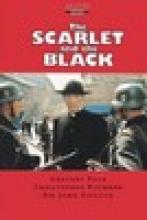The supporting cast of The Scarlet and the Black - Sir John Gielgud as Pius XII, Walter Gotell as General Max Helm, Raf Vallone as Father Vittorio and Olga Karlatos as Francesca Lombardo - ensure that Plummer and Peck don't carry the movie alone. Gielgud stands out, offering cautious encouragement to O'Flaherty's rescue efforts, while engaging in brinkmanship with Kappler over his priests' diplomatic immunity.
Olga Karlatos carries the burden of being one of the few female leads in The Scarlet and the Black, and she doesn't disappoint. In her, we see how the Italian citizen had to live under the Nazis: she maintains a strong face with O'Flaherty, but she knows that if the Nazis suspect her of subversive activities, she and her daughters will be shot.
On the face of it, the final confrontation between Kappler and O'Flaherty is a bit too Hollywood - the two men facing each other in the dark ruins of the Colosseum. But ironically, that scene probably holds the heart and soul of The Scarlet and the Black. O'Flaherty masterfully proclaims that humanity and goodness will endure, while utterly scorning everything Kappler stood for and represented. Kappler desperately believes in the power of Nazism, even as the SS prepares to evacuate Rome, and slyly demands that O'Flaherty save his wife and children. There's no music, no action, nothing to detract from the image of two men who embody completely opposite ideologies, facing each other one final time. It's a scene for the ages, played by two actors for the ages.
Behind the camera, director Jerry London and cinematographer Guiseppe Rotunno present Rome in all its greatness and mystery. The splendor and magnificence of the Apostolic Palace is contrasted with the shadowy and echoey streets of Vatican City at night, offering a very cerebral viewing experience and paralleling the two main characters - O'Flaherty's beacon of light and hope against the black of Kappler's SS uniform. If not for the archived footage of crowds celebrating the liberation of Rome (and Sir John Gielgud presumably waving to nothing but cameras), the illusion would be perfect and complete. Being a television movie, I imagine London had limited resources at his disposal, but what he does in creating the Rome of 1943 - including the classic opening of two senior SS officers marching through the Apostolic Palace, shiny jackboots and all - is captivating and engrossing nonetheless.
The Scarlet and the Black works on practically every front - Peck and Plummer are ably backed up by their supporting cast, London and Rotunno capture all the subtleties and grandeur of Rome, and Ennio Morricone scores with his oppressive military marches and blend of Gregorian chants. Occasionally, the movie seems incongruously light-hearted - a cute little melody plays while Kappler stares at O'Flaherty through a rifle scope, and sometimes O'Flaherty's jokes and pluck seem out of place - but it's a minor quibble. London and his team offer dramatic and gripping retelling of a priest's successful efforts to save literally thousands of lives under the noses of the greatest evil in history.
